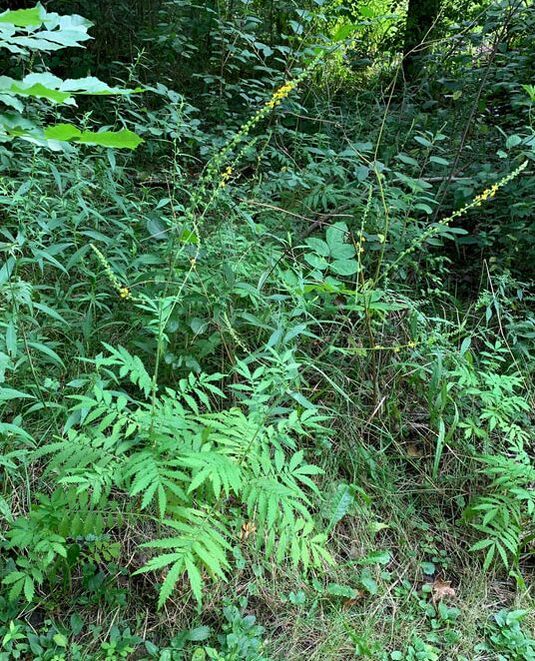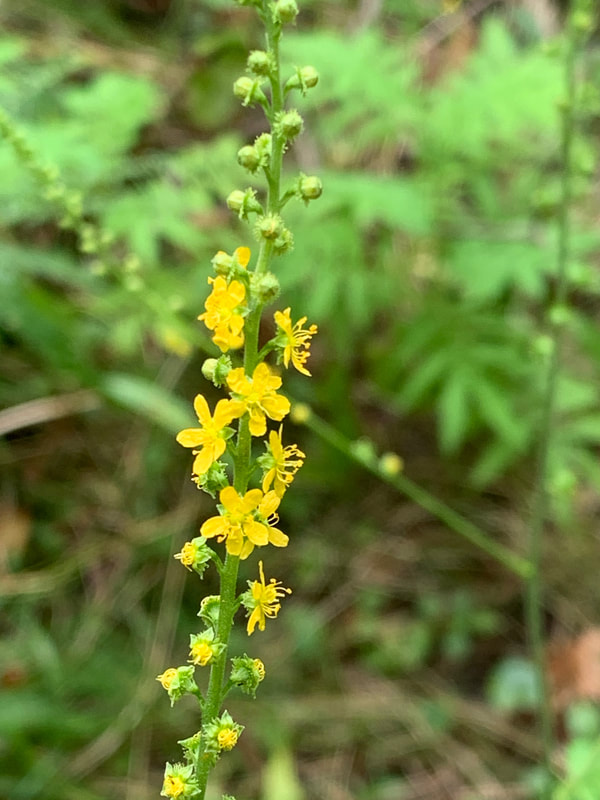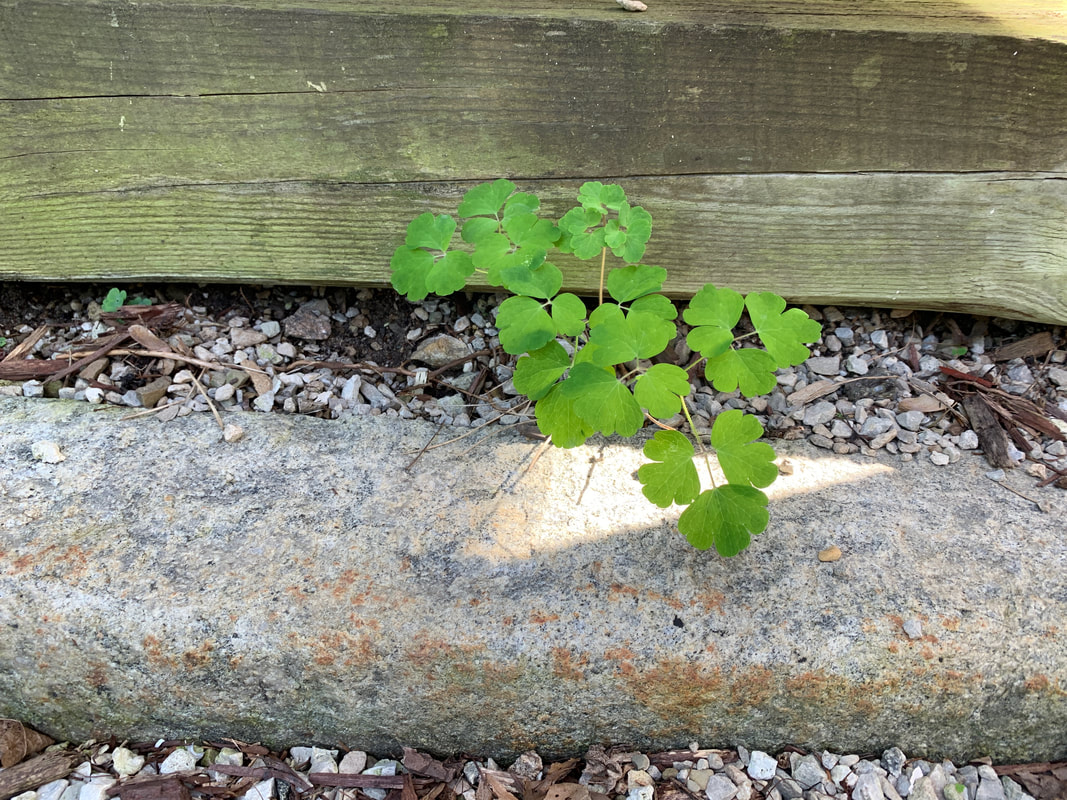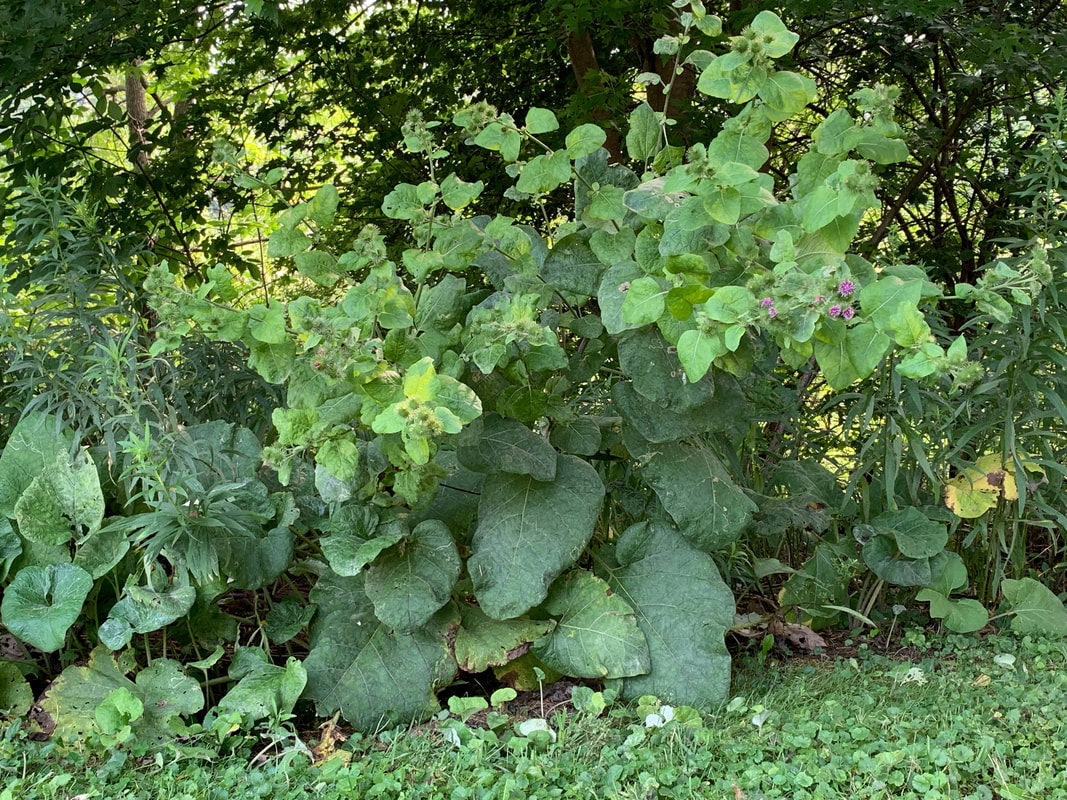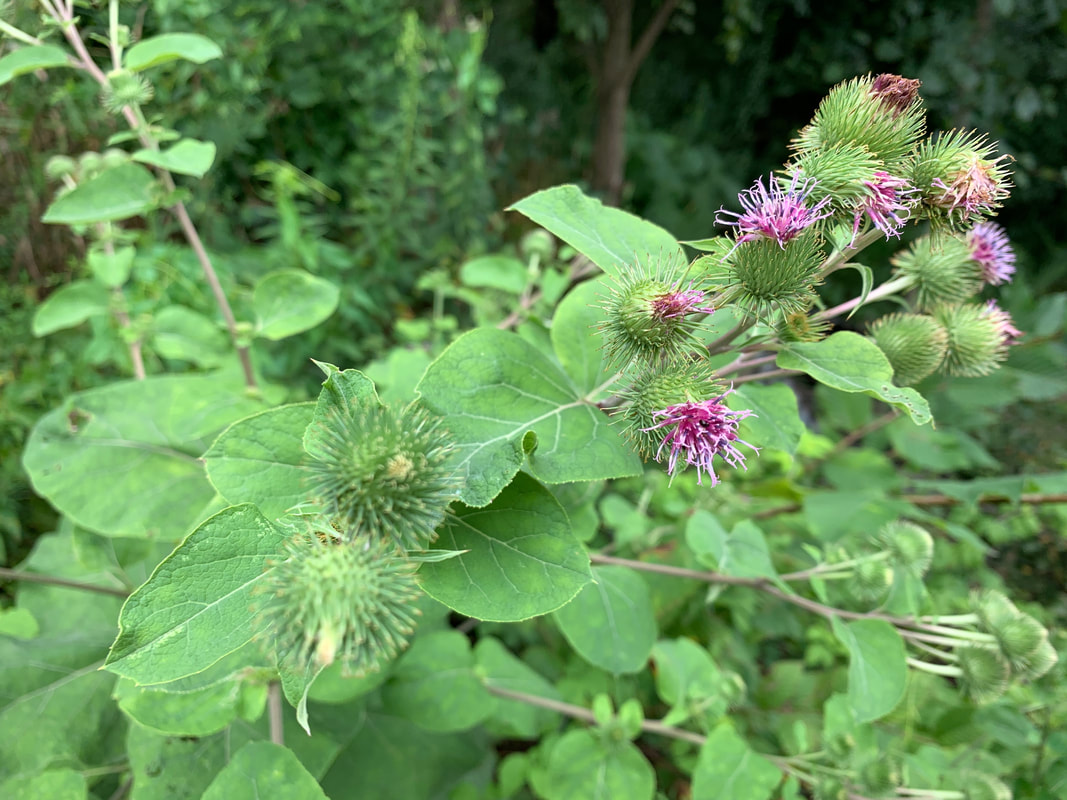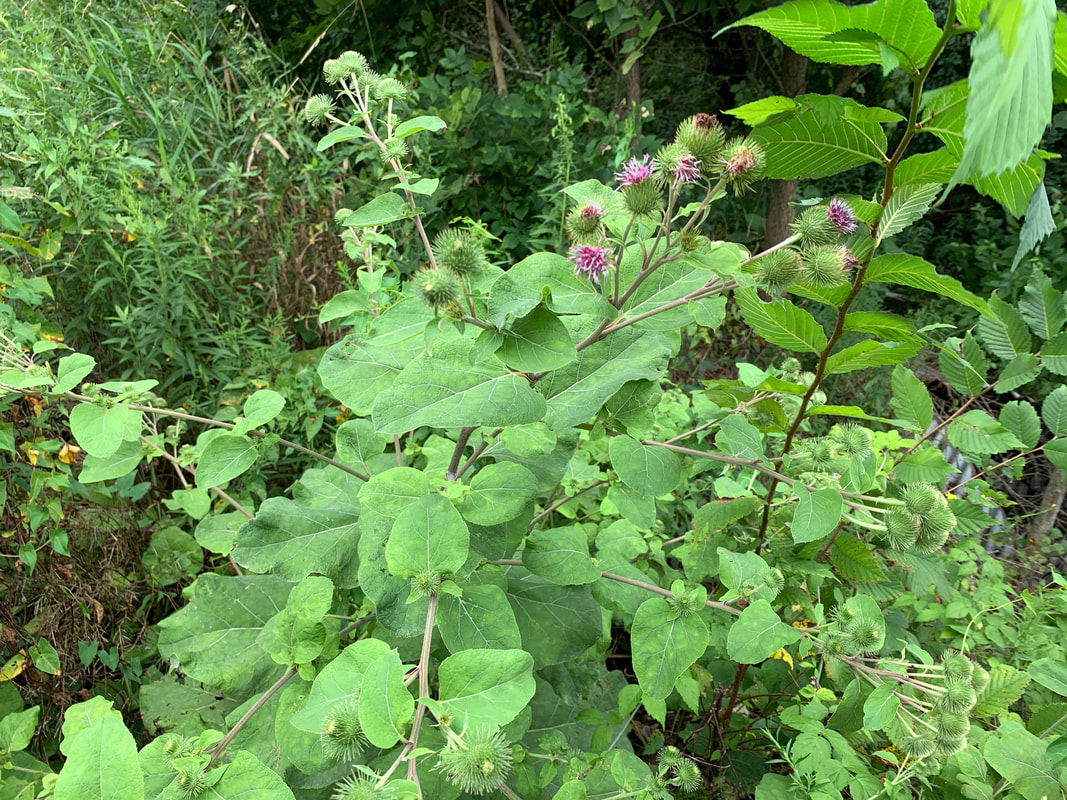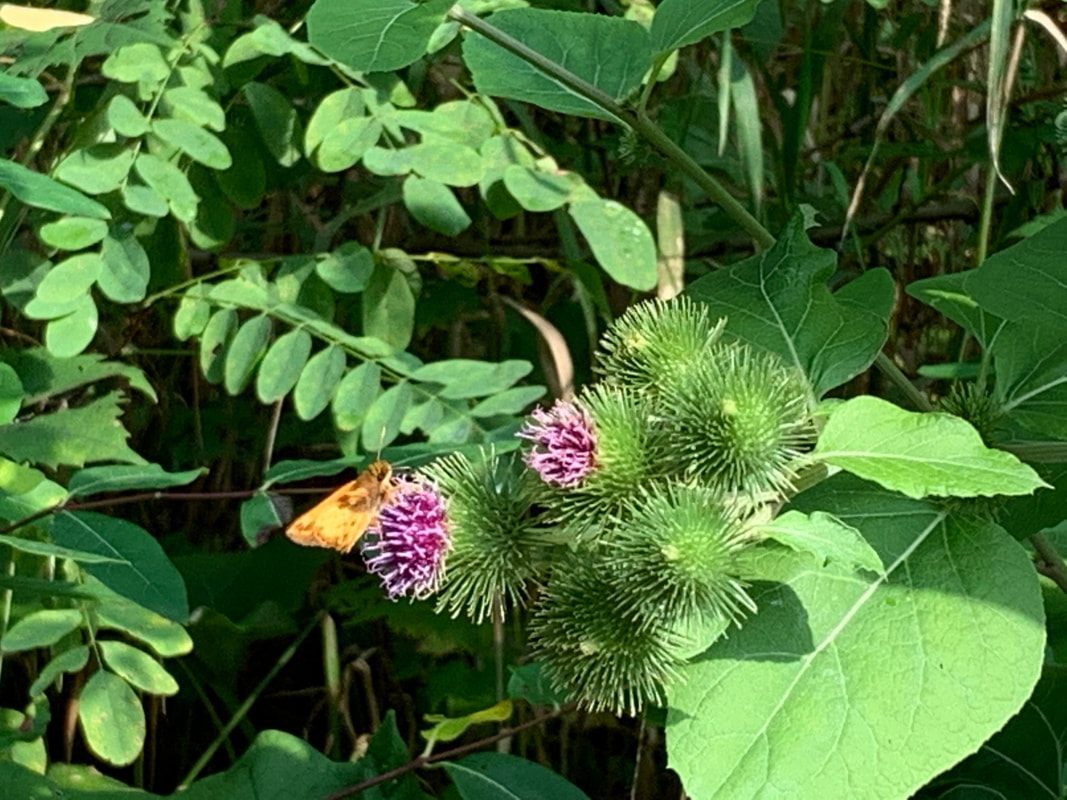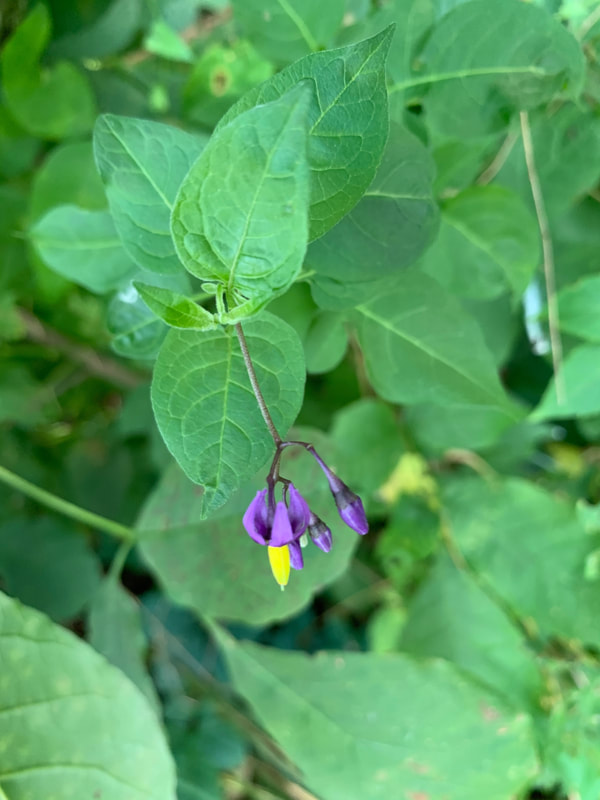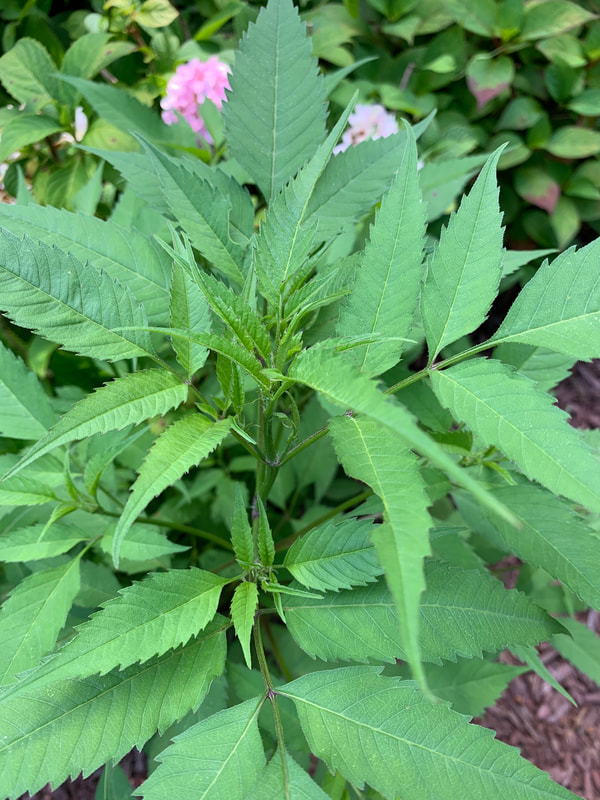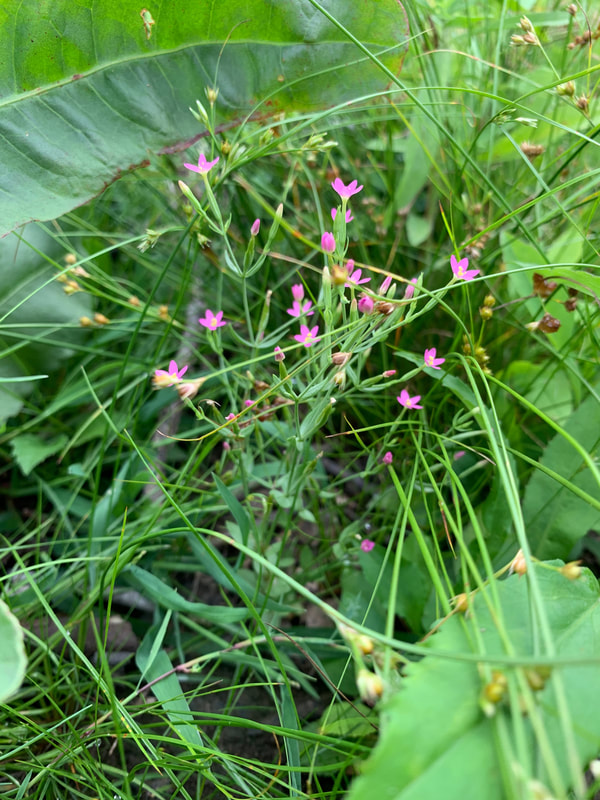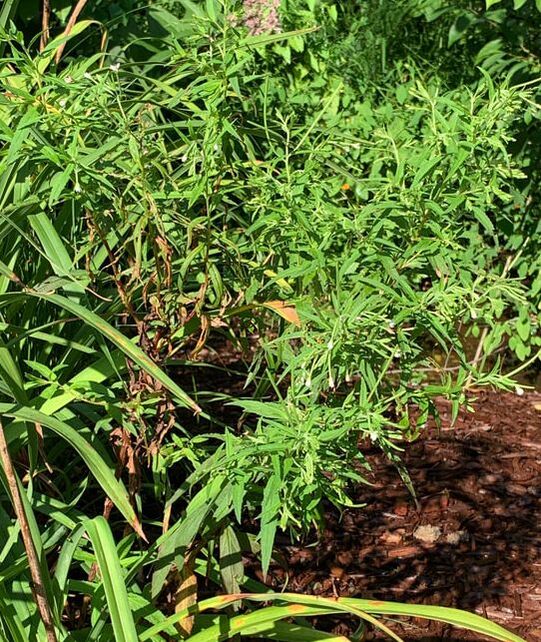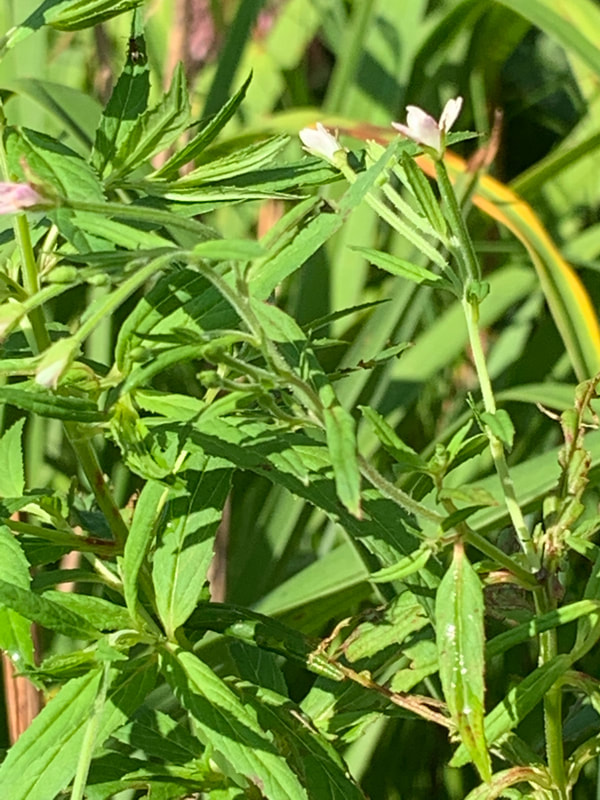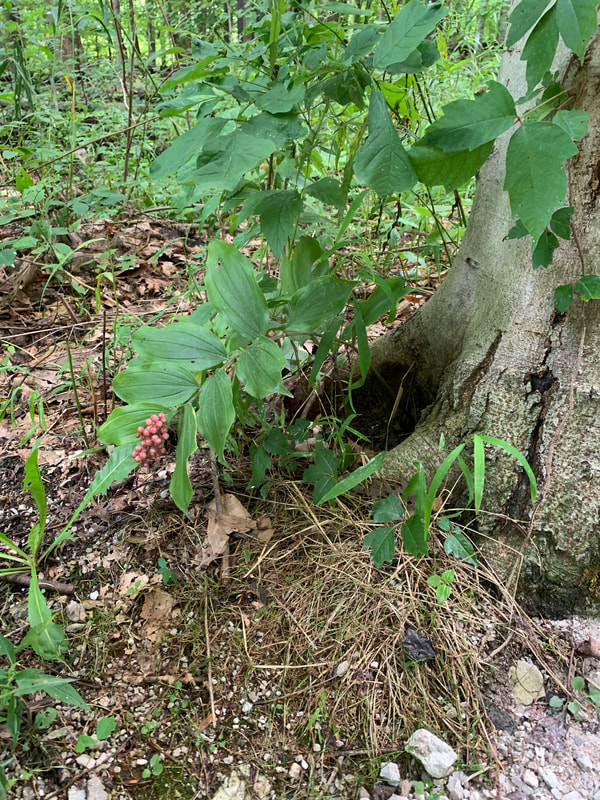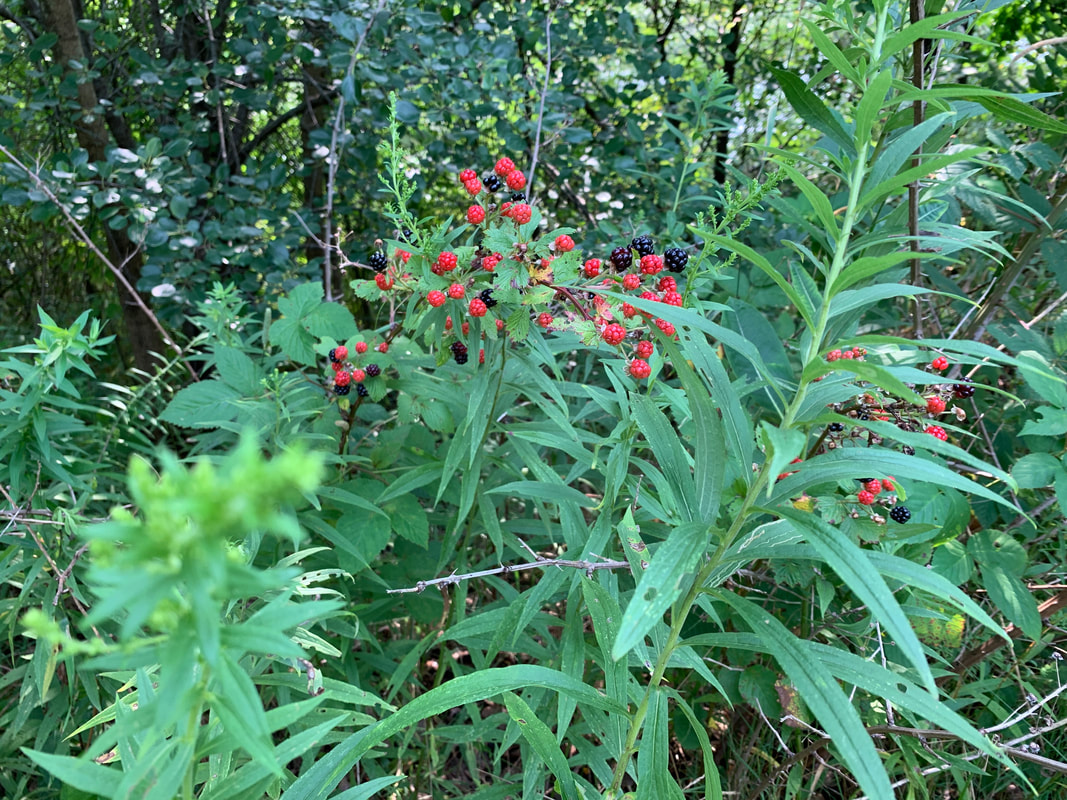Weeds (Wildflowers) Seen While Traveling Around & About:
Botanical and Historical Details on Each, in progress, and more coming soon ...
|
Contents:
|
14. Common Saint John’s Wort (Hypericum perforatum) 15. Jewelweed (Impatiens capensis) 16. Great Blue Lobelia (Lobelia siphilitica) 17. Morrow’s Honeysuckle (Lonicera morrowii) 18. Water Purslane (Ludwigia palustris) 19. Common Evening Primrose (Oenothera biennis) 20. Liverworts (Marchantiophyta family) 21. Wild / False Solomon’s Seal (Maianthemum racemosum) 22. Dawn Redwood (Metasequoia) 23. Blackberry Bramble (Rubus fruticosus) 24. Goldenrod (Solidago) 25. Prickly Sow-Thistle (Sonchus asper) 26. White Vervain (Verbena urticifolia) |
1)
Doll’s Eye / White Baneberry (Actaea pachypoda)
Doll's Eye
2)
Agrimony (Agrimonia eupatoria)
3)
Ramp (Allium tricoccum)
4)
5)
Greater Burdock (Arctium lappa)
6)
|
Bittersweet Nightshade (Solanum dulcamara)
Bittersweet nightshade (Solanum dulcamara) is not the same as deadly nightshade (Atropa belladonna). Both are named nightshades, as they both belong to the Solanaceae or nightshade family, both are poisonous (although the latter is far more so), despite both having long medicinal histories, and, at first glance, they share some similar features like variably teardrop-shaped leaves that can lobe at the stem side, striking, typically purple flowers, and having preferences for shadier, moister soils. However, they belong to different genera, have different growth habits (the bittersweet is more vining; the deadly is more shrub-like), flower shapes (the former’s are distinct star-shapes whose petals age to a bending backward, fully revealing brilliant yellow stamens and style; the latter’s are a forward leaning bell shape), and fruit (the former has smaller, bright red ripe berries, which are bitter, but enjoyed by blackbirds, thrushes, robins, and other birds; the latter has half-inch green berries that ripen to a gleaming black—the latter are also sweet, unfortunately, for both plants, and notably their berries, are |
|
very poisonous).* Another confusion can be between bittersweet nightshade and the common or black nightshade (Solanum ptycanthum), whose flowers look very similar, except that the latter’s are very pale lavender to white; further, the common/black nightshade is thusly named for the color of its deep black berries, versus bittersweet’s green-to-red ones, and is a more erectly growing plant, rather than bittersweet’s vining nature.**
So, let us look closer now at bittersweet nightshade. Its most common common name—bittersweet nightshade—comes to us as a translation of Dulcis amara, literally ‘sweet bitter,’ which it was called in Germany in the 16th century, that described how its stem, upon first taste, was sweet, then most bitter, due to the plant’s chemistry, its glycoalkaloid content dangerously breaking down into steroidal alkamine aglycones. Beyond that name, and its sometimes (and misleading) appellation of ‘deadly’ nightshade, it bears a great number more of common names, including: climbing nightshade, blue bindweed, blue |
nightshade, fellenwort, felonwort, myrtlevine, violet bloom, scarlet berry, amara dulcis, dulcamara, dwale, skawcoo, tether-devil, devil’s apple, soda apple, fevertwig, poison berry, poison flower, snakeberry, and wolf grape—the last five of these bearing reference to its medicinal properties. Introduced from Eurasia, bittersweet nightshade can be found throughout most of the U.S. (being absent or just unreported in a handful of southern states), especially in more moist and shadier areas, especially enjoying disturbed soils, open woods, and edges of woodlands, however can grow in full sun and along wastelands, fencerows, roadsides, etc.. Its growth habit starts rather scrubby, but develops scrambling, semi-woody vines as it gets larger—and it can become quite massive with nine to ten foot trailing or climbing arms—and is difficult to pull given its roots form both a central taproot and rhizomes. Its two to four inch leaves are arranged alternately around its green to green-purple stems and have fairly smooth edges, but otherwise bear diverse shape alterations, from teardrop to heart, to a rather round to pointed oval with or without one or two basal or rear lobes. The leaves and stems may emit a strongly bitter, rank odor if crushed. While its leaves are interesting, it is the flower that makes bittersweet nightshade stand out. Its plump purple buds burst open in five narrow petals dyed a gorgeous gradated pale to luxurious blue-violet, which then keep moving, bending backwards to reveal a prominently striking sunny golden yellow column composed of its fused stamens around its anthers and style, all while the whole flower head, clustered alongside others, all lean forwards to an elegant droop. At the expiration of the flowers, bittersweet nightshade develops coffee-bean sized fruits that come out green then blush to a brilliant, shiny red.
It is a bit of a shame that the plant is so very striking, given its high toxicity, tendency to overrun shrubs and small trees, and its difficulty to eliminate (be sure to wear gloves when pulling it). Aptly, bittersweet nightshade is listed as an invasive in Connecticut, New Hampshire, Pennsylvania, Kentucky, Michigan, Wisconsin, Oregon, and Washington, as well as on national park land at the Antietam site in Maryland and Minute Man park in Massachusetts. Bumblebees and Halictid bees pollinate its flowers, while its leaves and roots attract various beetles, and a handful of birds, from the grey catbird to wild turkeys and swamp sparrows, and some skunks and mice will eat its berries—all without suffering any of its toxicity that will so effect humans, pets, and livestock. Ingestion of any part of the plant can induce nausea, vomiting, salivation, diarrhea, dilated pupils, drowsiness, weakness, abdominal pain, paralysis of the central nervous system, slowing heart and respiration rates, loss of body heat, vertigo, delirium, convulsions, and death. Though, most poisons are also medicines, and the plant and its extracts have been used for skin diseases, warts and boils, eczema, acme, jaundice, tumors, cellulite, arthritis, rheumatism, bronchial congestion, heart problems, ulcerative colitis, cancer, and perhaps other conditions. While many medicinal recipes exist out there, most carry at least some banner warning of toxicity and encouraging professional handling only—for my part, I’ll admire the dangerously striking flowers as I encounter them elsewhere, and carefully pluck and dig out any seedlings I find sprouting around my home.***
* Cf., The Lost Herbs with Nicole Apelian page, available ~~HERE~~; Vialiigardens page, available ~~HERE~~; the RSPB page, available ~~HERE~~; Maryland Wild Plants page, available ~~HERE~~.
** Dennis Horn, Tavia Cathcart, Thomas E. Hemmerly, and David Duhl, Wildflowers of Tennessee the Ohio Valley and the Southern Appalachians (Auburn, WA: Lone Pine Publishing, 2018), 235-36.
*** Cf., Dennis Horn, Tavia Cathcart, Thomas E. Hemmerly, and David Duhl, Wildflowers of Tennessee the Ohio Valley and the Southern Appalachians (Auburn, WA: Lone Pine Publishing, 2018), 235; Malcolm Stuart, editor, The Encyclopedia of Herbs and Herbalism (London: Orbis Publishing, 1979), 265-66; Invasive Plant Atlas, available ~~HERE~~; U.S. Forest Service ‘Weed of the Week’ page, available ~~HERE~~; Plants for a Future page, available ~~HERE~~; North Carolina Extension Gardener Plant Toolbox, available ~~HERE~~; Illinois Wildflowers page, available ~~HERE~~.
It is a bit of a shame that the plant is so very striking, given its high toxicity, tendency to overrun shrubs and small trees, and its difficulty to eliminate (be sure to wear gloves when pulling it). Aptly, bittersweet nightshade is listed as an invasive in Connecticut, New Hampshire, Pennsylvania, Kentucky, Michigan, Wisconsin, Oregon, and Washington, as well as on national park land at the Antietam site in Maryland and Minute Man park in Massachusetts. Bumblebees and Halictid bees pollinate its flowers, while its leaves and roots attract various beetles, and a handful of birds, from the grey catbird to wild turkeys and swamp sparrows, and some skunks and mice will eat its berries—all without suffering any of its toxicity that will so effect humans, pets, and livestock. Ingestion of any part of the plant can induce nausea, vomiting, salivation, diarrhea, dilated pupils, drowsiness, weakness, abdominal pain, paralysis of the central nervous system, slowing heart and respiration rates, loss of body heat, vertigo, delirium, convulsions, and death. Though, most poisons are also medicines, and the plant and its extracts have been used for skin diseases, warts and boils, eczema, acme, jaundice, tumors, cellulite, arthritis, rheumatism, bronchial congestion, heart problems, ulcerative colitis, cancer, and perhaps other conditions. While many medicinal recipes exist out there, most carry at least some banner warning of toxicity and encouraging professional handling only—for my part, I’ll admire the dangerously striking flowers as I encounter them elsewhere, and carefully pluck and dig out any seedlings I find sprouting around my home.***
* Cf., The Lost Herbs with Nicole Apelian page, available ~~HERE~~; Vialiigardens page, available ~~HERE~~; the RSPB page, available ~~HERE~~; Maryland Wild Plants page, available ~~HERE~~.
** Dennis Horn, Tavia Cathcart, Thomas E. Hemmerly, and David Duhl, Wildflowers of Tennessee the Ohio Valley and the Southern Appalachians (Auburn, WA: Lone Pine Publishing, 2018), 235-36.
*** Cf., Dennis Horn, Tavia Cathcart, Thomas E. Hemmerly, and David Duhl, Wildflowers of Tennessee the Ohio Valley and the Southern Appalachians (Auburn, WA: Lone Pine Publishing, 2018), 235; Malcolm Stuart, editor, The Encyclopedia of Herbs and Herbalism (London: Orbis Publishing, 1979), 265-66; Invasive Plant Atlas, available ~~HERE~~; U.S. Forest Service ‘Weed of the Week’ page, available ~~HERE~~; Plants for a Future page, available ~~HERE~~; North Carolina Extension Gardener Plant Toolbox, available ~~HERE~~; Illinois Wildflowers page, available ~~HERE~~.
7)
8)Cress / Hairy Bittercress Weed (Cardamine hirsuta)
Cress
9)
10)
Creeping / European Bellflower (Campanula rapunculoides)
11)
Red Osier Dogwood (Cornus sericea)
12)
Queen Anne’s Lace (Daucus carota)
13)
14)
Common Saint John’s Wort (Hypericum perforatum)
15)
Jewelweed (Impatiens capensis)
16)
Great Blue Lobelia (Lobelia siphilitica)
17)
18)
Water Purslane (Ludwigia palustris)
19)
Common Evening Primrose (Oenothera biennis)
20)
Liverworts (Marchantiophyta family)
21)
|
False Solomon’s Seal (Maianthemum racemosum, previously Smilacina racemosa)
Please don’t think I am making a moral judgment by calling you false Solomon’s seal—for you and (true?) Solomon’s seal (Polygonatum, e.g., smooth P. biflorum or hairy P. pubescens) are both in the Liliaceae family (although different genera), enjoy similar growing habitats and conditions, bear resemblance to one another (although your flowers are somewhat feathery plumes at the ends of your stem, whereas the other holds hers like small bells tracing the stem’s underside), and were often used medicinally in the same ways. Solomon’s seal received her name by the scar her stems leave on her rhizome when they die back in the fall; your stems do leave a scar, too, but more of a simple circle, instead on one with an interior wax-seal-like marking. So, if you prefer, we could call you by your other common name, Solomon’s plume, or perhaps we just need to find a legendary wise person whose signatory seal was empty, perhaps a Zen master, or a minimalist, a Beckett or Sam Francis? Better, let us just get to know you for who you are truly. You are a native perennial who prefers moist, shady |
woodlands, one whose unbranched but slightly zig-zagging and delicately arching stems can reach up to three feet bordered perfectly with alternate, long and elliptic, prominently paralleled veined leaves; at your stem tip, a streak of two to six-inch panicles gorgeously dense with petite white to buttery cream and fragrant flowers that become clusters of beautiful small greenish and pink-speckled to dusty-pink to deep red berries. Small quantities of these are edible, as are your young shoots and processed roots (which are rhizomes with fibrous secondary ones), and Native Americans used all these parts of you medicinally. According to ethnobotanist Huron Smith’s study of the Ojibwe Native Americans, you were a helpful ‘revivor’ and also mixed with the root of spreading dogbane (Apocynum androsaemifolium) to help the kidneys during pregnancy and cure sore throats and heads. Birds and mice also quite enjoy your berries, and will help spread you about the woods or sometimes a lucky gardener’s shade bed (where you, as a hardy rhizome-plant and thus a strong clump former, will quickly form healthy new spreads).
The example pictured here was discovered on a walk in August in Hudson, Ohio.
* Cf., Dennis Horn, Tavia Cathcart, Thomas E. Hemmerly, and David Duhl, Wildflowers of Tennessee the Ohio Valley and the Southern Appalachians (Auburn, WA: Lone Pine Publishing, 2018), 421-22; Missouri Botanical Garden page, available here: http://www.missouribotanicalgarden.org/PlantFinder/PlantFinderDetails.aspx?kempercode=m390; Wisconsin Horticulture Division of Extension page, available here: https://hort.extension.wisc.edu/articles/false-solomons-seal-maianthemum-racemosum/; Lady Bird Johnson Wildflower Center page, available here: https://www.wildflower.org/plants/result.php?id_plant=marar; Huron H. Smith, Ethnobotany of the Ojibwe Indians (Milwaukee, WI: Order of the Board of Trustees, Public Museum of the City of Milwaukee, 1932), 374.
The example pictured here was discovered on a walk in August in Hudson, Ohio.
* Cf., Dennis Horn, Tavia Cathcart, Thomas E. Hemmerly, and David Duhl, Wildflowers of Tennessee the Ohio Valley and the Southern Appalachians (Auburn, WA: Lone Pine Publishing, 2018), 421-22; Missouri Botanical Garden page, available here: http://www.missouribotanicalgarden.org/PlantFinder/PlantFinderDetails.aspx?kempercode=m390; Wisconsin Horticulture Division of Extension page, available here: https://hort.extension.wisc.edu/articles/false-solomons-seal-maianthemum-racemosum/; Lady Bird Johnson Wildflower Center page, available here: https://www.wildflower.org/plants/result.php?id_plant=marar; Huron H. Smith, Ethnobotany of the Ojibwe Indians (Milwaukee, WI: Order of the Board of Trustees, Public Museum of the City of Milwaukee, 1932), 374.
22)
Dawn Redwood (Metasequoia)
23)
24)
Goldenrod (Solidago)
25)
Prickly Sow-Thistle (Sonchus asper)
26)
White Vervain (Verbena urticifolia)
¥ ¥ ¥ ¥ ¥ ¥ ¥ ¥ ¥ ¥ ¥ ¥ ¥ ¥ ¥ ¥ ¥
Return to {Nashville} Weed Inventory or Weed Reflections:
¥ ¥ ¥ ¥ ¥ ¥ ¥ ¥ ¥ ¥ ¥ ¥ ¥ ¥ ¥ ¥ ¥
© Dr. Mélanie V. Walton, 2021
Site powered by Weebly. Managed by MacHighway
